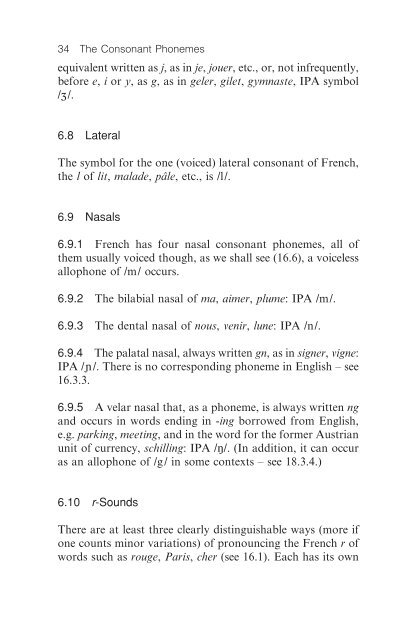An Introduction to French Pronunciation
An Introduction to French Pronunciation
An Introduction to French Pronunciation
Create successful ePaper yourself
Turn your PDF publications into a flip-book with our unique Google optimized e-Paper software.
34 The Consonant Phonemes<br />
equivalent written as j, as in je, jouer, etc., or, not infrequently,<br />
before e, i or y, as g, as in geler, gilet, gymnaste, IPA symbol<br />
/ʒ/.<br />
6.8 Lateral<br />
The symbol for the one (voiced) lateral consonant of <strong>French</strong>,<br />
the l of lit, malade, pâle, etc., is /l/.<br />
6.9 Nasals<br />
6.9.1 <strong>French</strong> has four nasal consonant phonemes, all of<br />
them usually voiced though, as we shall see (16.6), a voiceless<br />
allophone of /m/ occurs.<br />
6.9.2 The bilabial nasal of ma, aimer, plume: IPA /m/.<br />
6.9.3 The dental nasal of nous, venir, lune: IPA /n/.<br />
6.9.4 The palatal nasal, always written gn, as in signer, vigne:<br />
IPA //. There is no corresponding phoneme in English – see<br />
16.3.3.<br />
6.9.5 A velar nasal that, as a phoneme, is always written ng<br />
and occurs in words ending in -ing borrowed from English,<br />
e.g. parking, meeting, and in the word for the former Austrian<br />
unit of currency, schilling: IPA /ŋ/. (In addition, it can occur<br />
as an allophone of /g/ in some contexts – see 18.3.4.)<br />
6.10 r-Sounds<br />
There are at least three clearly distinguishable ways (more if<br />
one counts minor variations) of pronouncing the <strong>French</strong> r of<br />
words such as rouge, Paris, cher (see 16.1). Each has its own












